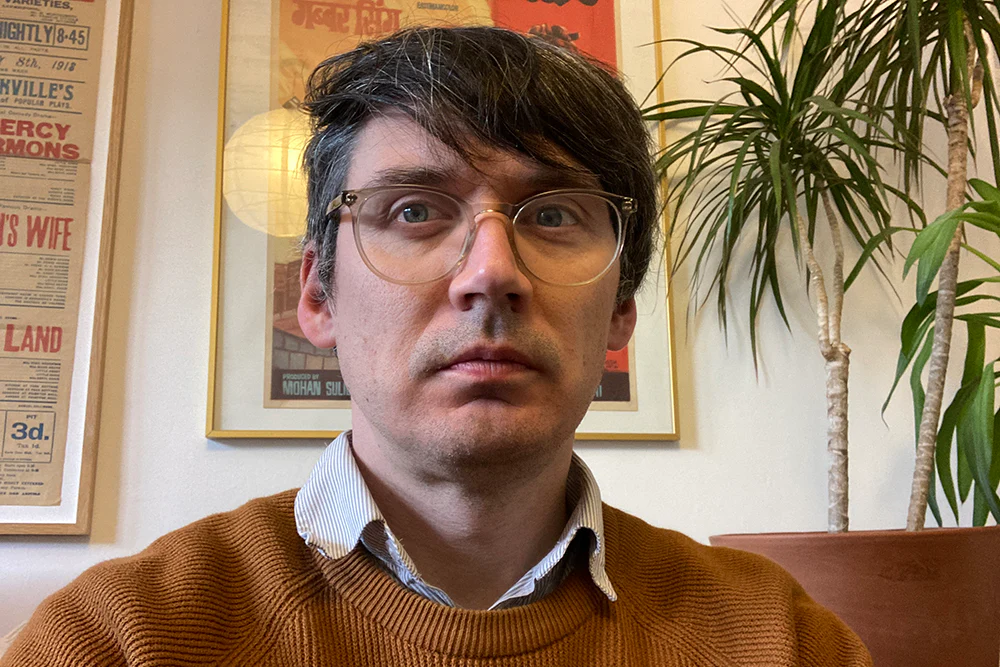
Oswin Tickler, Artefact
Our guest this week is Oswin Tickler, a designer and educator teaching primarily at London College of Communication. Oswin’s practice is centred around experimental publishing, the latest example of which is the new issue of Artefact magazine.
The magazine is produced, managed and edited by BA and MA Journalism students at LCC. For the new issue, published this week, Tickler has developed software to create a series of bespoke cover designs based on a series of elements he has designed—all 1000 copies of the magazine will have their own unique design.
What are you up to this Monday morning?
Porridge, an hour’s walk up around Hackney Marshes and back (in place of a commute—and a hangover from the pandemic), then checking emails and attacking whatever is on my never ending to do list.

Where are you?
I’m at home currently, where I mostly work when not teaching, and then travelling into college later to prep for teaching and workshop sessions I have coming up.

Which magazine do you first remember?
That is probably Farmer’s Weekly—although I don’t remember having any interest in it! There always seemed to be a copy of it near Papa’s (my dad’s dad) seat at the table, when we would go and stay on the farm ‘on holiday’.

Which magazine matters to you the most this morning?
I’m actually sifting through various piles of magazines for teaching purposes this morning. However, I’ve finally got round to Motor Dance Journal, which was designed by Audrey Solomon one of our recent MA publishing alumni, and it is great to finally spend a bit of time with it.

Describe the magazine in three words
Intimate. Calm. Rhythmic.
Outline the history of Artefact to date
Artefact is a magazine produced by final year BA and MA journalism students at London College of Communication, University of the Arts London. It was launched in 2014, together with a website and social media channels to allow journalists/students to explore topics and approaches that are authentic to their interests, experiences, backgrounds and identities. It appears three to four times a year and depending on the interests of the students involved covers art, culture, lifestyle, current affairs (both domestic and overseas) and aspects of student and university life.
The launch issue was designed by Scott King (SleazeNation, i-D) who was UAL's chair of visual communication. I was brought in to help him with that first issue, and then took the reins for issue two onwards.
The graphic elements combine in different positions and colours to create multiple cover layouts.
Tell us about the new cover and the technology behind it.
The technology is actually based on some experimental work I did for a previous LCC publication I did called ‘Our Algorithmic lives’ (which was printed, but never exhibited/distributed due to the pandemic). The printer FE Burman then showed it to HP indigo who asked me to help them develop and test the software they were building based on this method this led to the creation of HP Spark (still in Beta).

It operates as part of their smartstream designer suite of software which is a plugin for Adobe InDesign and Illustrator, which brings creative coding into a print environment, as a new way of creating variable artwork for print. So rather than designing it conventionally, it is all constructed via lines of code (P5.js) and you set parameters for what changes (colour, image…) and what stays the same (positioning, size…).
Using it for this cover is in part a way to showcase this innovating new approach to print, but I’m using it here to create these mini-narratives in relation to the issue’s —the cost of living crisis—and the way that it is impacting us all in different ways.
What other uses do you think the software you’ve developed might have? Part of the beauty of it is that I (and no one else) really knows the full potential of the software yet as you can work in very different approaches with it—and I’m enjoying exploring and figuring it out. HP Indigo and agencies are interested in it’s use across packaging, my background is obviously editorial, but I want to push the technology to deconstruct and question what editorial design is more. AI generated code may part of a step in that direction also (which I’ve tentatively looked at).
The great thing is that I’ve done a number of workshops now with different groups of students and professionals and the discussions we are having are helping me to see where other people can see potential in it.
I have an idea to print fabric with it—perhaps I’ll take to wearing mad algorithmically printed capes?!?
What are you most looking forward to this coming week?
I’m looking forward to getting a couple of jobs off to print, and the university spring break which starts at the end of the week—it has been a busy term!
Copies of Artefact will be available at main Univeristy of the Arts sites across London this month. We also hope to have some available at magCulture soon.


